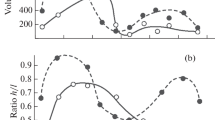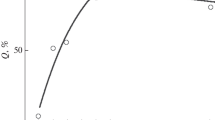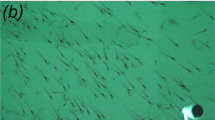Summary
Quantitative analyses of the effects of temporary blindfolding (BL) or lateralis section (LS) on the schooling performance of saithe (Pollachius virens) are reported. Comparison of effects of the sensory deprivations on school structure and dynamics allow determination of the relative roles of the lateral lines and vision in normal schooling. Extended 3-dimensional records were made of the positions of sensorily deprived individuals in normal schools as well as whole schools with sensory treatments.
-
1.
Blinding had little effect on the position experimental fish took up with respect to their neighbors within the school (Fig. 2). In contrast, lateralis section resulted in a great increase in the frequency of neighbors at 90° bearing (directly alongside) (Fig. 2).
-
2.
Both BL and LS fish exhibited different characteristic nearest neighbor distances (NNDs) than controls, with blinding increasing NND and lateralis section decreasing NND (Fig. 4).
-
3.
Importance of the lateral line in transmission of a fright response and sudden velocity changes within a school is demonstrated by experiments in which schools were intentionally startled. In schools of LS fish there exist significant relationships between latency to startle and the distance and angle between a fish and the startling object. Such relationships are not seen in normal schools: with intact lateral lines, fish respond with similar latencies to objects in all directions (Fig. 5).
-
4.
Fish which are blindfolded are able nonetheless to match short-term changes in velocity of their neighbors and actually show higher correlations than do controls (Fig. 8 b). Lateralis section does not reduce correlations between fish and neighbors (Fig. 8 d) probably because LS fish take up positions at which they can best determine neighbors' velocities by vision alone.
We conclude that the role of the lateral line in schooling is much greater than has been recognised previously. Our experiments suggest that characteristic NND in a travelling school is maintained by opposing forces of attraction and repulsion mediated by stimuli perceived by the visual and lateralis systems respectively. School structure and dynamics depend upon both senses, with vision primarily important for the maintenance of position and angle between fish and the lateral lines primarily important for monitoring the swimming speed and direction of travel of neighbors.
Similar content being viewed by others
Abbreviations
- LS :
-
lateralis section
- BL :
-
temporary blindfolding
- NND :
-
nearest neighbor distance
- NN1, NN2, NN3 :
-
nearest neighbor, second nearest neighbor and so on
References
Backus, R.H.: Sound production in marine animals. U.S. Navy J. Underwater Acoust.8(2), 1–32 (1958)
Bateson, W.: The sense-organs and perceptions of fish: with remarks on the supply of bait. J. Mar. Biol. Assoc. U.K.1, 225–256 (1889)
Breder, C.M., Jr.: Studies on the structure of the Fish School. Bull. Am. Mus. Nat. Hist.98, 7–28 (1951)
Breder, C.M., Jr.: Equations descriptive of fish schools and other animal aggregations. Ecology35, 361–370 (1954)
Breder, C.M., Jr.: Studies on the social groupings of fish. Bull. Am. Mus. Nat. Hist.117, 397–481 (1959)
Cahn, P.H.: Sensory factors in the side-to-side spacing and positional orientation of Tuna,Euthynnus affinis. U.S. Fish. Bull.70, 197–204 (1972)
Cahn, P.H., Shaw, E., Evans, F.C.: Lateral line nerve maturation related to development of schooling in the atherinid fishMenidia. Bull. Mar. Sci.18, 660–670 (1972)
Cullen, J.M., Shaw, E., Baldwin, H.: Methods for measuring the 3-D structure of fish schools. Anim. Behav.13, 534–543 (1965)
Disler, N.N.: Lateral line sense organs and their importance in fish behavior. Transi, from Russian, National Technical Information Service, Springfield, Va. (1963)
Harden-Jones, F.R.H.: Further observations on the movements of herring schools in relation to the tidal current. J. Con. Int. Explor. Mer.27, 52–76 (1968)
Hunter, J.R.: Communication of velocity changes in jack mackerelTrachurus symmetricus schools. Anim. Behav.17, 507–514 (1969)
Keenleyside, M.: Aspects of schooling behavior in fish. Behaviour8, 183–248 (1955)
Kendall, M.G.: Time-series. London: Griffen 1973
McNicholl, R.G., McKay, W.C.: Effect of DDT and MS222 on learning a simple response in rainbow trout. J. Fish. Res. Bd. Can.32, 661–665 (1975)
Major, P.F., Dill, L.M.: The three dimensional structure of airborne bird flocks. Behav. Ecol. Sociobiol.4, 111–122 (1978)
Moulton, J.M.: Swimming sounds and the schooling of fish. Biol. Bull.119, 210–223 (1960)
Nursall, J.M.: Some behavioral interactions of spottail shiners (Notropis hudsonius), yellow perch (Perca flavescens) and Northern pike (Esox lucius). J. Fish. Res. Bd. Can.30, 1161–1178 (1973)
Olst, J.C. van, Hunter, J.R.: Some aspects of the organisation offish schools. J. Fish. Res. Bd. Can.27, 1225–1238 (1970)
Oshima, Y.: An experiment on the shoaling behavior of fish: the case when two homotypic shoals consisting of large and small individuals met with each other. J. Jap. Soc. Sci. Fish.16, 195–200 (1950)
Parker, G.H.: The function of the lateral line organ in fishes. Bull. U.S. Bur. Fish.24, 183–207 (1904)
Parker, G.H., Heusen, J. van: The reception of mechanical stimuli by the skin, lateral line organs and ears in fishes, especially inAmeiurus. Am. J. Physiol.44, 463–489 (1917)
Parr, E.A.: A contribution to the theoretical analysis of the behavior of fishes. Occas. Pap. Bingham Ocean. Coll.1, 1–32 (1927)
Partridge, B.L.: Sensory aspects of schooling. D. Phil. thesis. University of Oxford. 520 pp. (1978)
Partridge, B.L.: The effect of school size on the structure and dynamics of minnow schools. Anim. Behav.28 (1980)
Partridge, B.L., Cullen, J.M.: A low-cost interactive coordinate plotter. Behav. Res. Methods. Instrum.9, 473–479 (1977)
Partridge, B.L., Dawkins, R., Amlaner, C.: Voltage controlled oscillators: inexpensive alternative to analog-digital converters. Behav. Res. Methods Instrum.10, 712–714 (1978)
Partridge, B.L., Pitcher, T.J., Cullen, J.M., Wilson, J.: The 3-dimensional structure of fish schools. Behav. Ecol. Sociobiol. (in press) (1980)
Pitcher, T.J.: The 3-dimensional structure of schools of the minnowPhoxinus phoxinus. Anim. Behav.21, 673–686 (1973)
Pitcher, T.J.: Sensory information and the organisation of behaviour in a shoaling cyprinid fish. Anim. Behav.27, 126–149 (1979)
Pitcher, T.J., Partridge, B.L., Wardle, C.S.: A blind fish can school. Science194, 963–965 (1976)
Shaw, E.: The schooling of fishes. Sci. Am.206, 128–138 (1962)
Shaw, E.: Some new thoughts on the schooling of fishes. FAO Fish. Rep.62, 217–233 (1968)
Shaw, E.: Schooling in fishes: critique and review. In: Development and evolution of behavior. Aronson E.R., Tobach, E., Lehrman, D.S., Rosenblatt, J.S. (eds.), pp. 452–480. San Francisco: Freeman 1970
Shaw, E.: Schooling fishes. Am. Sci.66, 166–175 (1978)
Siegel, S.: Nonparametric statistics for the behavioral sciences. London: McGraw Hill 1956
Sokal, R.R., Rohlf, F.J.: Biometry. San Francisco: W.H. Freeman 1969
Wardle, C.S.: Eimits offish swimming speed. Nature255, 725–727 (1975)
Wardle, C.S., Anthony, P.D.: Experimental methods used for the study of fish behavior in large tanks. I.C.E.S. CM1973, b:22 (1973)
Author information
Authors and Affiliations
Additional information
The work described in this paper formed part of a thesis submitted to the University of Oxford by BLP
We are indebted to Richard Dawkins, Mike Cullen and Tony Cook for many helpful discussions and ideas. We thank Jill Skelton for assistance with the plotting and are grateful to Clem Wardle, sory systems. Instead, they matched their velocities John Wilson, Bob Batty and the Department of Agriculture and Fisheries Marine Laboratory, Aberdeen, for help with the experiments and for providing facilities. The Department of Experimental Psychology, University of Oxford kindly provided computing facilities. We thank Walter Heiligenberg and Ron Thresher for commenting on the manuscript. Support for this work was provided by the Royal Society (Browne Foundation), the New University of Ulster Research Fund and postgraduate fellowships to BLP from the National Science Foundation (USA) and the National Research Council of Canada.
Rights and permissions
About this article
Cite this article
Partridge, B.L., Pitcher, T.J. The sensory basis of fish schools: Relative roles of lateral line and vision. J. Comp. Physiol. 135, 315–325 (1980). https://doi.org/10.1007/BF00657647
Accepted:
Issue Date:
DOI: https://doi.org/10.1007/BF00657647




